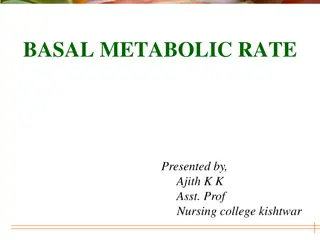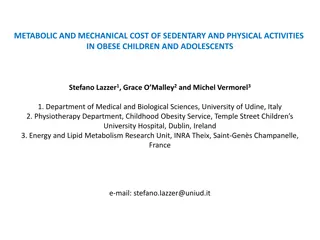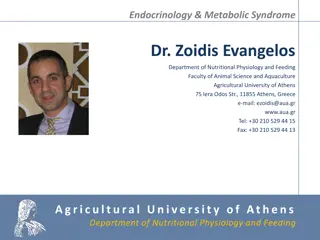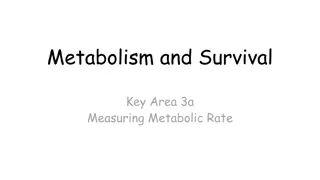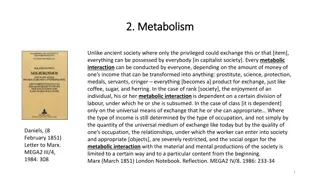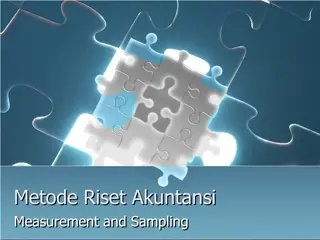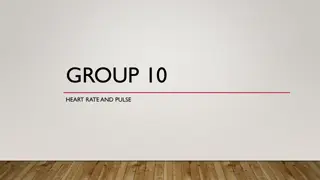Understanding Metabolic Rate in Biology: Measurement and Importance
Metabolic rate, the energy consumed by an organism in a specific time period, can be measured through heat energy, oxygen consumption, and carbon dioxide release. Various tools like calorimeters and respirometers are used for this purpose. The delivery of oxygen through efficient transport systems is crucial for aerobic respiration. Different circulatory systems, such as single circulatory systems in fish, play a vital role in oxygen delivery to body tissues. The processes and importance of metabolic rate and oxygen delivery in biology are discussed in detail.
Download Presentation

Please find below an Image/Link to download the presentation.
The content on the website is provided AS IS for your information and personal use only. It may not be sold, licensed, or shared on other websites without obtaining consent from the author. Download presentation by click this link. If you encounter any issues during the download, it is possible that the publisher has removed the file from their server.
E N D
Presentation Transcript
Higher Biology Metabolic Rate
Metabolic Rate The metabolic rate of an organism is the amount of energy consumed in a given period of time. It can be measured as: Heat energy produced per unit of time Oxygen used per unit of time Carbon dioxide released per unit of time. Friday, 13 September 2024 G R Davidson 2
Metabolic Rate A calorimeter can be used to measure metabolic rate. The temperature of the water going in and the temperature of the water coming out are measured to give a rise in temperature. This gives a rise in temperature over a period of time and this data can be used to calculate the metabolic rate. Friday, 13 September 2024 G R Davidson 3
Calorimeter Graphic of a person burning calories. Friday, 13 September 2024 G R Davidson 4
Metabolic Rate A respirometer can also be used to measure the metabolic rate of an organism. This is a container in which an organism is placed along with a chemical to remove CO2. The volume of oxygen consumed by the organism can be seen as coloured liquid moves through a capillary tube to replace the oxygen. Friday, 13 September 2024 G R Davidson 5
Respirometer Friday, 13 September 2024 G R Davidson 6
Oxygen Delivery As the rate of aerobic respiration increases so does the demand for oxygen. Therefore it is important that the cells have access to oxygen through an efficient transport system. In vertebrates the oxygen is delivered in blood which is pumped by the heart. Vertebrates all have a closed circulatory system. Friday, 13 September 2024 G R Davidson 7
Oxygen Delivery This means the blood is kept in a continuous loop of blood vessels. The heart pumps blood out into the largest of the vessels. These vessels get progressively smaller until they become capillaries. Capillaries have thin walls and this allows oxygen to be exchanged with the cells surrounding the capillary. Friday, 13 September 2024 G R Davidson 8
Single Circulatory System Single circulatory systems are found in fish. They are single because the blood only passes through the heart once for each body circuit. Blood is pumped from the heart to the gills at high pressure, where it will receive its oxygen. It then travels to the body tissues at low pressure where it will give up its oxygen. Friday, 13 September 2024 G R Davidson 9
Single Circulatory System Gill capillaries ventricle atrium heart Body capillaries Friday, 13 September 2024 G R Davidson 10
Incomplete Double Circulatory System A double circulatory system has blood flowing through it twice for each body circuit. In amphibians and reptiles the system in incomplete as there are two atria but only one ventricle. The right atrium receives blood returning from the body tissues. Friday, 13 September 2024 G R Davidson 11
Incomplete Double Circulatory System The left atrium receives blood returning from the lungs. The ventricle receives blood from both atria. This results in some mixing between oxygenated and deoxygenated blood. Friday, 13 September 2024 G R Davidson 12
Incomplete Double Circulatory System In amphibians this mixing isn t too much of a problem as the blood returning from the body has been partially oxygenated by the moist skin of the organism. In reptiles, mixing is reduced by the presence of a septum which partially divides the ventricle. Friday, 13 September 2024 G R Davidson 13
Incomplete Double Circulatory System lung capillaries right atrium left atrium heart ventricle body capillaries Friday, 13 September 2024 G R Davidson 14
Complete Double Circulatory System A complete double circulatory is found in mammals and birds. It is described as complete because the heart has 2 atria and 2 ventricles and the blood passes through the heart twice for each body circuit. This means there is no mixing of the blood and so makes this system the most efficient. Friday, 13 September 2024 G R Davidson 15
Complete Double Circulatory System lung capillaries right atrium left atrium heart right ventricle left ventricle body capillaries Friday, 13 September 2024 G R Davidson 16
Circulatory Systems Vertebrate Type of Circulation Heart Features Fish Single 2 chambers Low pressure Tissue blood not completely oxygenated Good pressure and complete oxygenation Amphibians & Reptiles Incomplete double 3 chambers Mammals & Birds Complete double 4 chambers Friday, 13 September 2024 G R Davidson 17
Lung Complexities Amphibians can use their skin to exchange gases. They can also use their mouth cavity. They have lungs which are very inefficient due to a very small surface area. They will usually only use their lungs during vigorous activity. Friday, 13 September 2024 G R Davidson 18
Lung Complexities Reptiles and mammals have a breathing system containing many branching tubes ending in many alveoli. These alveoli have very thin walls and are moist to increase the efficiency of gas exchange. This provides plenty of oxygen for aerobic activities. Friday, 13 September 2024 G R Davidson 19
Lung Complexities Birds are the most active group of vertebrates, needing even more oxygen than the other vertebrates. They have additional air sacs over and above the lungs. These are designed to keep more air flowing through the lungs. Friday, 13 September 2024 G R Davidson 20
Physiological Adaptations for Low Oxygen Niches There are some animals which can survive in low oxygen environments such as high altitude, under water, etc.. Humans function best at sea level where the oxygen content of the air is about 20%. However, at high altitudes, the air is thinner and contains less oxygen. Friday, 13 September 2024 G R Davidson 21
Breathing in Birds Friday, 13 September 2024 G R Davidson 22
Physiological Adaptations for Low Oxygen Niches The body responds by increasing the number of red blood cells. This makes up for the less oxygen in the air and allows the blood to carry the oxygen it needs. The process of making the extra blood cells takes a few weeks. Friday, 13 September 2024 G R Davidson 23
Physiological Adaptations for Low Oxygen Niches Bloodworms live in mud which contains very little oxygen. To help them survive in this environment, they have haemoglobin in their body cells which can absorb any available oxygen from their surroundings. Friday, 13 September 2024 G R Davidson 24
Physiological Adaptations for Low Oxygen Niches Marine mammals need to be able to dive for long periods and also be able to cope with increasing pressure as they go deeper. To achieve this they can slow down their heart rate which helps them conserve oxygen. Another adaptation they have is the ability to collapse their lungs which reduces their buoyancy. This allows the animal to conserve energy which can then be used in the hunt for food. Friday, 13 September 2024 G R Davidson 25
Maximum Oxygen Uptake The maximum volume of oxygen that an individual can take up during vigorous exercise is called the maximum oxygen uptake or VO2 max. VO2 max is used as a measure of cardiovascular fitness in humans. The person needs to be fitted with a carbon dioxide and oxygen analyser. Friday, 13 September 2024 G R Davidson 26
Maximum Oxygen Uptake They then exercise on an ergometer such as a treadmill or exercise bike. The VO2 max is reached when the oxygen consumption stays steady even when the workload is increased. The VO2 max can be improved with training. Friday, 13 September 2024 G R Davidson 27
Measuring VO2 max http://www.unchainedfitness.com/wordpress/wp-content/uploads/2011/08/VO2MAX3.jpg http://upload.wikimedia.org/wikipedia/commons/d/db/Ergospirometry_laboratory.jpg Friday, 13 September 2024 G R Davidson 28











